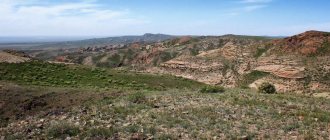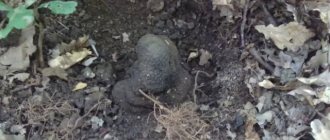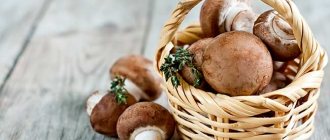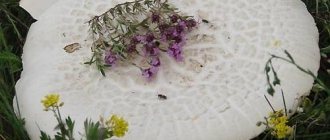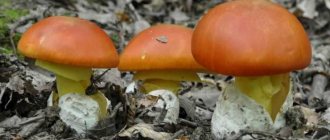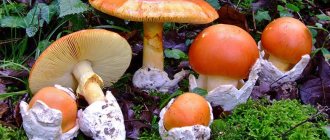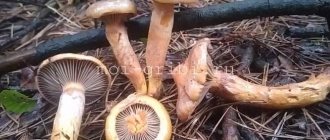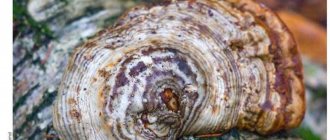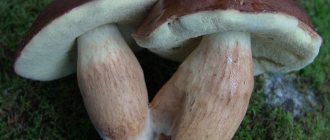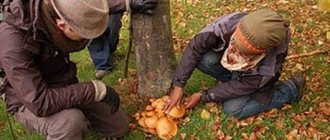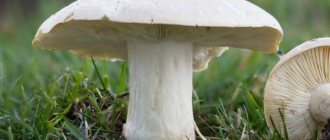Characteristics of single-barrel mushrooms
Despite the fact that single-barrel fruits have distinct characteristic features, they can be confused with inedible and even poisonous fruits, so you should be extremely careful when collecting them.
Appearance and photo
The fruit has a wide (from 4 to 30 cm) flat-convex cap with a curled edge. Old individuals can be distinguished by the funnel-shaped shape and smooth skin of the cap. Due to the shape of the cap, inexperienced mushroom pickers may confuse a single barrel with a chanterelle. The color changes from gray (or white) to yellow during the life of the fetus.
The leg is smaller than the cap, has a shape narrowed towards the base and is white or brown in color. The age of the fetus can also be assessed by the very cobwebby, cotton wool-like interior of the stem. Because it is too small, it is often not visible and may give the impression that the mushroom is growing without it at all.
Morphology
The single barrel has rare but fairly wide plates. Its flesh is white and quite dense. Old fruits lose the elasticity of the pulp and it becomes loose. The fruits have a pleasant, faint mushroom smell. The single-barrel mushroom is often called the most delicious mushroom from the Oyster mushroom family. The spores need grass to develop, which explains where the fungi spread.
Place of distribution in Crimea
Mushroom pickers advise going for a rich harvest to the valleys near Mount Demerdzhi, the Bakhchisarai forests, and the steppes near the Donuzlav and Sasyk estuaries. In addition to the Crimean region, single barrels can be found in the Lower Volga region.
Single-barrel oyster mushrooms differ from other varieties of the oyster mushroom family in their rather specific place of growth - they love the grassy cover of the steppe. While all other mushrooms usually grow under trees, single-barrel mushrooms can be found in open, damp areas. During periods of severe drought, you don’t have to look for them, because, despite their steppe habitat, they really love water.
Eating
Single barrels can be eaten and even more so - they are quite valuable for cooking. Mushroom pickers believe that these fruits are the most delicious among all members of the family and therefore are very popular. In addition, this variety contains a large amount of useful substances.
Can be used for drying, pickling, and preparing a variety of dishes. Please note that old mushrooms can only have caps. The legs become rougher with age, sometimes you even have to clean the joints between the knives and the caps.
Collection rules and conditions
Single barrels bear fruit almost all year round, from April until November. In especially warm years, fruits can grow even in early March, so when going into the forest you can almost always find them.
Difference from false, inedible mushrooms
Most often in collection areas you can find false mushrooms, pale toadstools and fly agaric mushrooms. Mushroom pickers advise not to put the entire harvest in one basket and not to rush to collect everything you find in the clearing, because inedible mushrooms grow apart from others.
You can distinguish an edible fruit by the way it grows: unlike many other edible and poisonous mushrooms, the one-barrel mushroom grows in groups and quite often the stems of the fruit are either as close to each other as possible, or even grow together and it seems that the fruit has several caps at once. This is the surest sign of this delicious fruit.
Steppe mushrooms of Crimea photo and description. Description and names of Crimean mushrooms (+27 photos)
Description: Mushrooms of Crimea and Crimean mushroom pickers))
NOT ALL MUSHROOMS IN THE PHOTOS IN THE GROUP ARE EDIBLE!
THE GROUP ADMINISTRATION IS NOT RESPONSIBLE FOR DETERMINING THE TYPES OF MUSHROOMS, THEIR EDITABILITY AND TASTE QUALITIES!
Friends! A huge request to all group members! Be careful and careful in your advice! In connection with the increasing frequency of classifications of mushrooms as “toadstools”, I really want to clarify. There is a version that the name "toadstool" in relation to mushrooms comes from the name of the bird - toadstool, the meat of which has a very unpleasant taste. Only one fly agaric has a scientific name with the word “toadstool” - and this is the well-known pale toadstool. Most mushrooms in the world have their own names, their own unique qualities. Absolutely edible mushrooms can look unsightly, taste bitter and smell whatever you like. And deadly poisonous ones can have an attractive appearance and a wonderful mushroom aroma. Several deadly poisonous and many mushrooms containing toxic substances grow in Crimea. The fact that someone ate a mushroom and did not end up in the hospital with poisoning does not mean that his health was not irreparably harmed by one or another poison contained in mushrooms. Let's take care of our health and the health of our loved ones and do not quickly put unknown mushrooms on your plate, or those that someone told you are edible. There is only one way (besides laboratory tests) to be sure that a mushroom is edible - to know its exact name. Knowing it, you can read for yourself in sources (books, the Internet) about its edibility or inedibility, and only then calmly eat it or say goodbye to this mushroom forever! Place: ◄◄ Mushrooms of Crimea ►►, Simferopol
24,707 entries Show community posts
WELCOME TO OUR GROUP!! SUCCESSFUL GROOMING TO YOU!!
If you don’t know the name of the mushroom you found or have any doubts, you can ask the group members for help. It is advisable to photograph mushrooms as shown in the picture below. Photographs of mushrooms in their natural environment (in the forest), in natural light, information about the smell of the mushroom, in what area the mushroom was found (mixed forest, pine, deciduous, in the grass, in the steppe, etc.) will also help. And please do not wash the mushrooms before photographing them for identification. This way, group members will be able to help you more accurately.
I would also like to note that when joining a group or asking for help, you must remember that it consists of thousands of participants, and not all of them are experienced mushroom pickers, know the exact names of mushrooms, or know how to distinguish one species from another. Therefore, we strongly recommend that you always double-check the names of mushrooms suggested in the group, and never trust statements that a mushroom is edible if its intended name is not stated (so that you can check the information about edibility/toxicity yourself by reading about this mushroom in the sources available to you: books, the Internet -sites). Even if a mushroom picker with extensive experience and knowledge assures you of this, and does it very convincingly. Remember, anyone can make a mistake! And we remind everyone who thoughtlessly approaches the issue of identifying mushrooms that this is prohibited by the group rules. Anyone found to be systematically violating this rule will be subject to a one-month ban.
The group periodically posts descriptions of Crimean mushrooms with photographs, which you can find using the hashtag #description of mushrooms. Just click on the hashtag in this post and all descriptions of mushrooms that were published in the group will be available to you. Basically, descriptions of mushrooms are taken from the reference guide of mycologist I.S. Sarkina “Familiar and unfamiliar mushrooms.”
https://jeduvkrym.ru/sovety-gribnikam-gde-rastut-griby-v-krymu-i-kak-otlichit-horoshie-griby-ot-yadovityh/https://ogorod-bez-hlopot.ru/opisanie- gribov-kryma.htmlhttps://vk.com/crimea3
Useful properties and restrictions on use
Single barrels are valuable not only for their taste, but also for their high content of nutrients. In terms of the amount of vitamins and amino acids, representatives of this variety are close to meat and dairy products. The only vegetables that contain more protein than single-sided vegetables are legumes.
Eating fruits can also help cope with the following diseases and conditions:
- decreased immunity;
- atherosclerosis;
- high cholesterol levels.
Single barrels contain a huge amount of vitamins (especially group B), antioxidants, and beneficial acids. Their effectiveness in the treatment of anemia has been proven, and can be used to influence the symptoms of liver, kidney, and eye diseases.
The mushroom has a unique tonic. Some athletes use single barrels to get a dose of energy before competitions, as a natural alternative to doping drugs. Like other mushrooms, single-barrel mushrooms are not included in the diet of children, pregnant and lactating women, and patients with gastrointestinal pathologies.
Recipes and cooking features
The most common and easiest way to cook single barrels is to marinate. To do this, you will need to rinse well and clean the fruits from soil, sand, and grass residues. After this, you should boil the water - the mushrooms should be added only after boiling. On average, they need to be cooked for no longer than 30-40 minutes, stirring occasionally and skimming off the foam. The marinade recipe for steppe mushrooms is very simple.
To prepare, you will need the following ingredients (per 1 liter of water):
- 3 teaspoons vinegar;
- 2 tablespoons each of crystalline sugar and salt;
- a pair of bay leaves;
- pepper and cloves to taste.
Collection rules
The collection season is highly extended. Fruiting bodies can ripen from April to June, while their life expectancy is short. The fruiting body can grow in a matter of days, and in warm springs the ripening time is reduced. Mushroom pickers go around the distribution areas starting at the end of March.
When collecting, it is recommended to take into account the structural features and follow the basic rules:
- Using a small sharp knife, cut off the leg at the very base;
- the collected specimens are laid out on prepared cloth in a basket so that the caps are not squeezed;
- Before drying, the caps are blown out, as a large amount of sand, dust, and grass particles accumulate in them.
Mountain white mushroom
It has many names: giant pigwort, huge leusopaxillus. But the most accurate thing is the giant talker (Trichlomocha family). Prefers the soil of deciduous and coniferous forests. Found from early summer to mid-autumn.
p, blockquote 5,0,0,0,0 –>
Mountain porcini mushrooms grow in groups. If one is found under a birch or pine tree, there is a high probability that there are several more nearby. It's easy to spot them. The caps are large and fleshy (up to 20 cm in diameter). They can be completely white, but they also come in a pleasant coffee-with-milk color. If the mushroom is completely white, it means it is young and fresh. The hat should be smooth on top and covered with plates with bridges on the bottom.
How does the steppe oyster mushroom reproduce?
Reproduction of the fungus can occur in three ways:
- vegetative - carried out using parts of the mycelium located underground. Individual threads of mycelium can separate from the main mass, continuing to grow independently, building up a huge system;
- asexual - reproduction using spores that have flagella. With gusts of wind they can disperse over tens of kilometers. In order for a mycelium to form from a spore, it penetrates the soil and begins to develop if environmental conditions allow. The growth of young fungi requires two spores of opposite sexes to be located next to each other;
- sexual - carried out during the formation of secondary mycelium, when the primary mycelial threads merge in pairs. In a similar way, additional underground mycelium is formed, from which young mushrooms grow.
Mice (gray row)
There are several types of rows that can be eaten. But they are quite difficult to distinguish from inedible ones. More often, mice are found in coniferous and mixed forests, in moss or on sandy soil. Rows can grow singly or in groups.
p, blockquote 12,0,0,0,0 –>
In Crimea they are found in early or mid-autumn. Experienced mushroom pickers go specifically for them to the forests near the village of Kolchugino or to the area of the Crimean Astrophysical Laboratory.
p, blockquote 13,0,0,0,0 –>
The hats of young mice (5-10 cm) have a conical shape with rolled edges. In mature rows it is flat, fleshy, with irregularities. The edges are unraveled and have small cracks. A small bump protrudes in the center. The plates in it are rare and widely spaced. The color of the cap is gray (from light to dark shade). After rain, it looks slimy and becomes slightly sticky, which causes leaves and small lumps of earth to stick to it, making it difficult to notice.
p, blockquote 14,0,0,0,0 –>
The stem of the row is dense, long (up to 12 mm), thickened at the base. In mature rows it becomes hollow inside. The color of the leg is pale yellow or grayish below. A plaque is visible next to the cap. The pulp of the mushroom has a dense but fragile structure with a faint powdery odor.
p, blockquote 15,0,0,0,0 –>
p, blockquote 16,0,0,0,0 –>
Mice can be salted, boiled, marinated. After boiling, they prefer to fry them and serve them as a tasty addition to main courses. Although they are very tasty in soups, casseroles, salads, and sauces.
p, blockquote 17,0,0,0,0 –>
Before cooking, they need to be sorted out, removing wormy mushrooms, dirt and pine needles. It is advisable to then soak for two hours in salted water with the addition of citric acid. If the mushrooms have a strong aroma, you can add a bay leaf or a couple of black peppercorns to the water to beat it off.
p, blockquote 18,0,0,0,0 –>
Poisonous
On the Crimean Peninsula they also encounter poisonous specimens. You should go on a “quiet hunt” only if you know how to distinguish edible mushrooms from inedible representatives.
fly agaric
Description. The red fly agaric is a poisonous mushroom whose appearance is recognizable to everyone. The cap is located on a high stem, up to 2.5 cm thick. As it matures, the cap rises to a height of up to 20 cm. By this time, from the shape of a hemisphere, it takes on an umbrella appearance, reaching up to 20 cm in diameter. There are characteristic white inclusions on the surface of the red cap.
Varieties. Deadly poisonous mushrooms include the white spring fly agaric, which is considered the closest relative of the toadstool - it is similar in appearance to it. It is distinguished by a white cap when fully expanded, acquiring a flat shape at maturity, 10 cm in diameter. At the initial stage of growth, the cap of the mushroom is spherical. Leg height – up to 12 cm.
Who can be confused with? It is impossible to confuse the red fly agaric with any mushroom.
Where does it grow and when? The red fly agaric is found in mixed forests with a predominance of conifers, on acidic soils. Begins to bear fruit from August to October.
Satanic mushroom
Description. Satanic mushroom is a poisonous specimen with predominantly white or slightly yellowish flesh. When broken, the flesh becomes bluish or reddish. The fruiting bodies have a slightly spicy odor when young; mature mushrooms smell like rotten onions. They have a spherical or barrel-shaped leg, red-yellow at the top, reddish-orange at the bottom, and reddish in the middle.
Who can be confused with? The satanic mushroom is similar to other boletus mushrooms, especially the first-class porcini mushroom.
Where does it grow and when? The mushroom grows in deciduous forests with calcareous soils next to chestnut, oak, hornbeam, and beech. The fruiting bodies ripen from June to September.
Cherry-brown silverfish
Description. The inedible mushroom Lepiota squamata (red-brown silverfish) in its youth is dominated by a convex cap, which over time becomes plano-convex, reaching 2-5 cm in diameter. The cap is whitish, covered with brownish-reddish scales. The leg is cylindrical, 4-8 cm in height. The surface is smooth, yellowish or slightly pinkish.
Who can be confused with? The cherry-brown silverfish can be confused with an edible specimen, Lepiota corypus.
Where does it grow and when? The mushroom bears fruit from June to September-October. Found in coniferous, mixed and deciduous forests, pastures, meadows, and vegetable gardens. It has an unpleasant rare smell and a disgusting taste.
False foam
Description. There are several varieties of false mushrooms. They are all similar in appearance. These are small lamellar mushrooms with a cap diameter of no more than 7 cm and a stem length of less than 10 cm.
Varieties. The following types of false mushrooms are found on the territory of Crimea:
- Sulfur yellow. Poisonous mushrooms, growing in groups, have fused bases of the legs. The young mushroom has a bell-shaped cap, which becomes flat over time, but retains the characteristic tubercle in the center. The diameter of the cap is no more than 5 cm, sulfur-yellow or bright yellow-brown in color. It is distinguished by a cylindrical stem, often curved and the same color as the cap.
- Brick red. A bell-shaped red-orange cap, with a smooth surface and yellowish plates that turn black as they ripen. The leg is thin, hollow inside and usually slightly curved.
Who can be confused with? The mushroom is confused with the edible honey mushroom.
Where does it grow and when? False mushrooms are found in forests where the fungi infect spruce, aspen and birch, settling in large groups on stumps. Fruiting continues from the beginning of summer until the end of October.
Death cap
Description. A deadly poisonous mushroom with a grayish or greenish cap, up to 15 cm in diameter. The shape resembles a hemisphere, then opens up and becomes flat. The mushroom has white flesh with a weak odor and taste.
Who can be confused with? Due to inexperience, toadstool can be confused with champignons or russula.
Where does it grow and when? The pale grebe prefers to grow on fertile soils, light mixed oak and beech forests. Fruits in early summer. Occurs singly or in groups.
False fox
Description. False chanterelle is a poisonous mushroom with a golden or yellowish convex, sometimes funnel-shaped cap, 2-5 cm in diameter. The center of the cap is darker than the edges. It is dominated by a thin stalk of a reddish color with a characteristic orange tint.
Who can be confused with? False chanterelles are often confused with edible mushrooms. But the main difference between these species is the edges of the cap: in the false mushroom they have an uneven shape, in the edible chanterelles they are wavy.
Where does it grow and when? False chanterelle grows in mixed forests. The fruiting bodies ripen in August and last until the end of autumn.
Lepiota brown-red
Description. A poisonous mushroom with a cap of the fruiting body, thin-fleshy in consistency, covered with dark scales on top and plates on the reverse side. At the beginning of ripening, the cap is bell-shaped, then becomes flat with a characteristic dark tubercle in the center. The diameter of the cap is up to 7 cm. The thin, sometimes curved stem of the mushroom is white on top and dark red below.
Who can be confused with? Outwardly, it somewhat resembles a pink wave.
Where does it grow and when? Fruits in mid-June until the end of summer. It is found in individual specimens or groups in forest plantations, squares, gardens, and parks.
Patouillard fiber
Description. Patouillard fiber is a deadly poisonous mushroom with a bell-shaped cap at the beginning and then spread out, with a characteristic tubercle in the center. It cracks in old age. Young mushrooms have a whitish cap, which later becomes reddish, straw-yellow. The leg is dense, slightly swollen at the base. Length – up to 7 cm. Color is the same as the hat.
Who can be confused with? The poisonous mushroom is confused with some varieties of champignons and entolomas.
Where does it grow and when? Putayara fiber grows from May to October in coniferous and deciduous forests. It appears abundantly in August and September in places where caps, champignons and other edible mushrooms grow.
Poisonous talkers
Description. Talker mushrooms can be of different colors. The young mushroom has a hemispherical cap, which then becomes depressed. The fleshy and large cap reaches a diameter of at least 10 cm. In normal weather, the surface of the mushroom is smooth and dry. The club-shaped leg reaches up to 8 cm in height.
Varieties. There are the following types of poisonous talkers:
- Pale. The cap of the mushroom is off-white or grayish, sometimes with brown or gray spots. The young talker is distinguished by a convex cap with smooth, turned-up edges. In adulthood, the cap becomes horizontally flat. The curved cylindrical leg reaches up to 5 cm in height.
- Reddish. It is distinguished first by a convex cap with rolled edges, then by a flat shape with a depression in the center. The surface of the cap of a young mushroom is white, covered with frost. Often strange reddish spots are visible on the cap. The cylindrical stem reaches a height of up to 4 cm. The mushroom has a powdery odor or smells like a recently cut tree.
- Waxy. A mushroom with a convex, then flat, slightly later concave, funnel-shaped cap, 3-8 cm in diameter. The edges of the cap are curled and turned up. The color is whitish, with a gray-cream tint, and dark edges. Sometimes there are dirty pink spots on the surface. The color of the leg varies from whitish to dirty ocher. The shape is cylindrical, often curved. Smells of wood and flowers.
Poisonous pale talker
Poisonous reddish talker
Poisonous waxy talker
Who can be confused with? The red talker can be confused with the edible meadow mushroom.
Where does it grow and when? Poisonous talkers grow in coniferous and deciduous forests, most often under oaks, spruce, pine and beech trees. The fruiting season begins in summer and ends at the end of autumn.
Tiger row
Description. Tiger row has a spherical cap, 4-10 cm in diameter. Gradually the cap becomes more convex, then completely spread out with thin edges turned down. There are specimens with caps ranging from off-white to silver-bluish. On the surface of the cap there are small scales spreading out in flakes in a circle. The height of the cylindrical leg reaches up to 12 cm, 2-4 cm in diameter.
Who can be confused with? Has no edible counterparts.
Where does it grow and when? Tiger rowers grow in small colonies, like a “witch’s ring.” Rarely found alone. The fruiting bodies form a symbiosis with coniferous trees and are occasionally found in mixed and deciduous forests. They prefer to create mycorrhizae with pines, beeches, lindens, spruces, and oaks. They bear fruit from August to late October-early November.
Champignon dark scale
Description. The dark scaly champignon is characterized by a convex, pale brown cap with dark scales, 6-10 cm in diameter. It grows on a long, smooth white stem. The plates of the mushroom are frequent, pale, grayish-pink, becoming brown in maturity. It has white flesh that does not change color when cut, except that it turns slightly yellow at the base of the stem.
Who can be confused with? The mushroom is confused with the edible forest champignon with reddened flesh.
Where does it grow and when? The poisonous mushroom is found extremely rarely in the autumn. It is found on the soil in deciduous forests, on compost heaps, and rotting straw.
Chanterelles
Another name is cockerels. The lands of the Simferopol region are rich in them. There are many of them near the village of Mramornoe. Mushroom pickers also go to the forests of Belogorsk, Kirov, and Bakhchisarai regions.
p, blockquote 19,0,0,0,0 –>
Chanterelles grow in numerous groups in sunny places, in clearings or next to clearings. They are also found in moss, among birches, pines, and spruces. Appear from the beginning of June. You can collect all summer until the first autumn frosts.
p, blockquote 20,0,0,0,0 –>
A distinctive feature of the structure: the mushroom does not have a pronounced transition from the stem to the cap. Uniform color: yellow (shades vary from light to dark, almost orange).
p, blockquote 21,0,0,0,0 –>
The hat has an irregular shape with wavy, unfolded edges that form a depression in the center. But its surface is absolutely smooth. The leg tapers downwards, the length is about 5 cm. The flesh is fleshy, dense, with a slightly sour taste. When pressed, it acquires a reddish tint. The smell is weak.
p, blockquote 22,0,0,0,0 –>
It must be distinguished from the false chanterelle, whose cap has no bends and resembles small funnels. In addition, their color is always orange, closer to red. The yellow hedgehog also looks like a chanterelle. This is an edible yellow mushroom. It has a fleshier cap and a thicker white stalk.
p, blockquote 23,1,0,0,0 –>
Chanterelles are very good for health. They help get rid of helminths, have a beneficial effect on liver cells (containing ergosterol in mushrooms), and are a source of vitamins. Increases the body's resistance to infections.
p, blockquote 24,0,0,0,0 –>
Chanterelles are easy to transport; they do not break when carried. You can cook it in any form. True, when fried they somewhat lose their taste. Pairs well with other mushrooms, such as porcini and boletus.
p, blockquote 25,0,0,0,0 –>
Dung beetles or coprinuses
At night there was a warm rain. On a hillock, among the wet grass, arrows of wheatgrass, steel-gray helmets emerged from the ground. And all in a dense army. One to one. Shoulder to shoulder. People were hurrying past. Everyone was busy with their own thoughts and worries. And no one noticed the miracle. And it was here - next to the roaring city, next to huge houses, next to ordinary life.
Read also: Row mushroom (50 photos): poplar, gray, green, edible and inedible, description, cap, what they look like, how to close
Small silvery heads, as if sprinkled with powdery powder, shimmered in the rays of the morning sun. The edges of the caps smoothly bent to the short thick legs. These were gray dung beetles, or gray coprinus.
This name unites a whole group of species: summer and autumn honey fungus, or true honey fungus, meadow honey fungus, winter mushroom. V. Toibis also includes the garlic mushroom in the group of honey mushrooms, calling it the garlic mushroom, and there is also the greater garlic mushroom.
This group of mushrooms ranks first in frequency of occurrence in nature. The most widespread edible mushroom in July can be considered the summer honey fungus, which settles in large families on stumps, logs, and rotten deciduous trees. The most common and abundant mushroom in October is the autumn honey fungus. Honey mushrooms are distributed throughout almost the entire territory of the former Soviet Union. Among the urban population of Crimea, almost 60% of mushroom pickers collect honey mushrooms, mainly in autumn.
Autumn honey mushrooms
Real autumn honey mushrooms are collected everywhere from the end of August to the end of autumn. These mushrooms almost never grow alone. They usually parasitize whole families on trees and stumps. Prefer moist soil.
p, blockquote 26,0,0,0,0 –>
In young honey mushrooms, the cap is concave inward, with growth it opens and becomes flat (size from 2 to 15 cm). The legs are long - up to 10 cm. The color of the caps and legs is the same - honey, but they have flake-like scales of a dark color, which is why honey mushrooms look brownish and slightly fluffy. There is a filmy ring under the cap.
Secrets of experienced mushroom pickers for you
Any business has its tricks, and there are some when picking mushrooms in the forest:
- It is more convenient to go for mushrooms with a strong basket and a penknife;
- Whitefish prefer to live on the edges of birch forests, among young trees;
- If your trip to the forest occurs in August, it is a good idea to walk in the forest with a stick so that you can touch suspicious bumps with it first, and not with your hand, this way you can protect yourself from snakes;
- During the season when mosquitoes are especially rampant, you need to take with you a means to protect against them, otherwise a trip to the forest will turn into hard labor;
- Clothing must be appropriate so that all areas of the body are covered. Upon returning from the forest, you need to take off your clothes and inspect them for the presence of ticks, which become active in the fall;
- You need to go to the forest on a clear day, it’s easier to navigate by the sun;
- I taste all suspicious mushrooms; if they are not bitter, I take them with me until I find out their name;
I always cut the white mushroom in half so as not to carry wormy mushrooms with me and not to fill the baskets with substandard ones.
It will be interesting to learn about where the amazing ram mushroom grows and how to collect it here
Common boletus
They are distributed everywhere, but there are especially many of them in the Belogorodsky region of Crimea, in the village of Zelenogorskoye, as well as in Strogonovka and on the Ai-Petri plateau. Growing season: June – end of October. They love bright meadows and forest edges. Found in meadows. Insects like to eat boletus, so in the summer mushrooms are often simply eaten away by them. But by autumn the situation will normalize.
p, blockquote 30,0,0,0,0 –>
It is very difficult to confuse boletus with other mushrooms. Their name speaks for itself. The fleshy, juicy caps seem to be smeared with oil: they are slippery and slimy, brown or light brown in color. In mature butterflies, the caps open, taking on the shape of hemispheres. The older the mushroom, the higher the edges. The skin is easy to separate from the pulp. Under the cap there is a tubular layer with small yellow pores.
p, blockquote 31,0,0,0,0 –>
The legs are lighter than the cap, thin, up to 10 cm long. A white ring is clearly visible on a mature mushroom.
p, blockquote 32,0,0,0,0 –>
Butternuts cannot be stored for a long time, so after harvesting they must be cooked quickly. Before cooking (frying, boiling, canning), you need to remove the thick skin and sort them. All wormy mushrooms are thrown away. Then they are soaked for an hour in water with salt and completely cleaned of dirt.
p, blockquote 33,0,0,0,0 –>
Before marinating, they are boiled for 15-20 minutes. During cooking, you can add a little onion to the water, this will add piquancy to the future dish. Next, they need to be tipped into a colander and dried a little. Pickled in any way.
p, blockquote 34,0,0,0,0 –>
The boletus is frozen, boiled in water (cooking time - 5 minutes), dried and placed in small portions in plastic bags. After defrosting, butter mushrooms are stored for only a short time, so you only need to take out the required amount of mushrooms from the freezer.
p, blockquote 35,0,0,1,0 –>
Milk mushrooms
Mushroom pickers come across mushroom pickers in mixed forests in the summer. Rarely found in the foothills and mountainous regions of Crimea. The main harvest season is July and September. Active growth begins after heavy rains.
p, blockquote 36,0,0,0,0 –>
There are no real milk mushrooms in Crimea, but oak, pepper and dry milk mushrooms grow. Pepper milkweed can be distinguished by its funnel-shaped white cap with grayish spots. On its narrow plates drops of milky juice are noticeable, which tastes very bitter. The leg is short, narrowed below. You can eat the mushroom after repeated soaking.
p, blockquote 37,0,0,0,0 –>
The dry milk mushroom also has a white cap, but with brown spots. The plates have a bluish color. The bitter juice does not appear after breaking. The mushroom is ideal for pickling and pickling (after pre-soaking).
p, blockquote 38,0,0,0,0 –>
In the mountainous part of Crimea you can find oak milk mushrooms. These reddish lamellar mushrooms grow in deciduous forests. Brown stripes are easily visible on their caps. Legs with yellow pits lose their density as they grow. Suitable for marinating, frying, boiling.
p, blockquote 39,0,0,0,0 –>
Raincoats
Puffballs are mushrooms that cannot be poisoned. But when collecting them, you still need to check their flesh: in a real raincoat it is always white. Giant and pear-shaped raincoats are common in Crimea. The first has a fruit body that is round and white, but becomes yellowish over time. Can reach a height of 34 cm.
The fruiting body of the pear-shaped puffball is very similar in shape to a pear. The skin is rough with small tubercles. Raincoats grow in the foothills, choosing rotten wood for themselves.
Only young mushrooms are suitable for food. They are dried or fried. They also make a delicious mushroom soup. In terms of nutritional content they can be compared with white ones.
>
Saffron milk caps
Appear in forests from July. They love shade and cool places under trees. They grow in large groups. In Crimea, their recognized place is Rybachye; they are also often found in the forests of the southern coast of Crimea.
p, blockquote 40,0,0,0,0 –>
The orange caps grow up to 12 cm in diameter. The bottom has reddish plates that turn green when pressed. the skin on them is a little sticky. The hollow legs, up to 2 cm thick, have dimples. The flesh of saffron milk caps is dense, sweet and has a fruity aroma.
p, blockquote 41,0,0,0,0 –>
Ryzhiki can be prepared in any way. They are salted very quickly: within two hours you get delicious salted mushrooms. The main thing is to add more spices.
p, blockquote 42,0,0,0,0 –>
Tips for mushroom pickers
Mushroom pickers have their own ethics of behavior, consisting of simple but very useful rules. For example, there is no need to kick mushrooms that are not of interest to you. Perhaps someone else will rip them off. For mushrooms, a basket made of twigs is best suited, since plastic bags do not allow air to pass through and, as a result, your collected “harvest” may not make it home.
You cannot break off the stems of the mushroom along with the mycelium, just as you cannot tear the moss. Under the sun's rays, the open mycelium will dry out and die. The most favorable conditions for the appearance of mushrooms are warm rain. That is, if there was a light rain in the evening, then in the morning you can safely go on a quiet hunt
Attention, the most important rule! If you're not sure, don't take the mushroom. At any slightest suspicion, it is better to just leave him in the forest. After all, life is much more important than the “harvest”
After all, life is much more important than the “harvest”.
What can be collected in Crimea.
